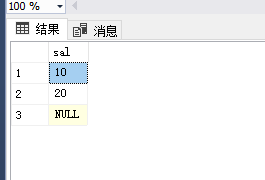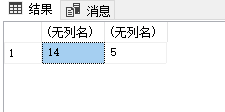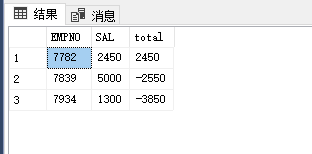avg的注意事项
一张t2表:
select * from t2

select AVG(sal) from t2
得到的结果是:

本来我们得到的结果应该是10的。但是得到的结果确实15.
这是因为忽略了null值。
解决方案:
当为空的时候转换为0
select AVG(coalesce(sal,0)) from t2
max 与 min的注意事项
max与min会忽略null,但是如果全是null的情况,会返回null值。
select DEPTNO,max(COMM)
from EMP
where DEPTNO in (10,30)
group by DEPTNO
例如:

解决方法:
如上文
select DEPTNO,max(coalesce(COMM,0))
from EMP
where DEPTNO in (10,30)
group by DEPTNO
sum
sum 计算的时候会忽略null值。
如上:
解决:
select DEPTNO,sum(coalesce(COMM,0))
from EMP
where DEPTNO in (10,30)
group by DEPTNO
计算行数
通常我们计算行数,通常是使用count。
同样是会忽略null值:
select COUNT(*),count(COMM)
from EMP

累计和
要实现下面这种效果:

比如2600,是红框部分的和。
假设前两列的效果是:
select e.EMPNO, e.SAL
from EMP e
order by 1
要求写出第三列的效果。
答案:
select e.EMPNO, e.SAL,(select SUM(d.SAL) from EMP d where d.EMPNO<=e.EMPNO) as total
from EMP e
order by 3
累计乘
如何实现累计乘法?
有一个数学概念:

select e.EMPNO, e.SAL,(select exp(sum(log(d.SAL))) from EMP d where d.EMPNO<=e.EMPNO and d.DEPTNO=e.DEPTNO ) as total
from EMP e
where DEPTNO=10
order by 3
累计差
分情况讨论,当是第一个直接输出第一个。后面的就是全部是负值相加然后加两个EMPNO最小值。
select e.EMPNO, e.SAL,(select case when e.EMPNO=MIN(d.EMPNO) then sum(d.SAL)
else sum(-d.SAL)+(select f.SAL from emp f where f.EMPNO=MIN(d.EMPNO))*2
end from EMP d where d.EMPNO<=e.EMPNO and d.DEPTNO=e.DEPTNO ) as total
from EMP e
where DEPTNO=10
order by EMPNO
